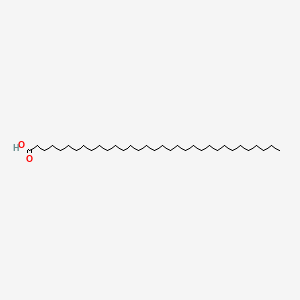| MeSH term | MeSH ID | Detail |
|---|---|---|
| Diabetes Mellitus, Type 2 | D003924 | 87 associated lipids |
| Body Weight | D001835 | 333 associated lipids |
| Hypercholesterolemia | D006937 | 91 associated lipids |
tritriacontanoic acid
tritriacontanoic acid is a lipid of Fatty Acyls (FA) class. Tritriacontanoic acid is associated with abnormalities such as hypercholesterolemia, Metabolic syndrome, Diabetes Mellitus, Non-Insulin-Dependent, Diabetes Mellitus, Insulin-Dependent and Parkinson Disease. The involved functions are known as Fermentation, Process, Longterm Effects, Pressure- physical agent and Lipid Metabolism. Tritriacontanoic acid often locates in Blood, Tissue fiber and A Fibers. The associated genes with tritriacontanoic acid are STN gene. The related lipids are Total cholesterol and blood lipid.
Cross Reference
Introduction
To understand associated biological information of tritriacontanoic acid, we collected biological information of abnormalities, associated pathways, cellular/molecular locations, biological functions, related genes/proteins, lipids and common seen animal/experimental models with organized paragraphs from literatures.
What diseases are associated with tritriacontanoic acid?
tritriacontanoic acid is suspected in hypercholesterolemia, Metabolic syndrome, Diabetes Mellitus, Non-Insulin-Dependent, Diabetes Mellitus, Insulin-Dependent, Parkinson Disease and other diseases in descending order of the highest number of associated sentences.
Related references are mostly published in these journals:
| Disease | Cross reference | Weighted score | Related literature |
|---|
Possible diseases from mapped MeSH terms on references
We collected disease MeSH terms mapped to the references associated with tritriacontanoic acid
PubChem Associated disorders and diseases
What pathways are associated with tritriacontanoic acid
There are no associated biomedical information in the current reference collection.
PubChem Biomolecular Interactions and Pathways
Link to PubChem Biomolecular Interactions and PathwaysWhat cellular locations are associated with tritriacontanoic acid?
Visualization in cellular structure
Associated locations are in red color. Not associated locations are in black.
Related references are published most in these journals:
| Location | Cross reference | Weighted score | Related literatures |
|---|
What functions are associated with tritriacontanoic acid?
Related references are published most in these journals:
| Function | Cross reference | Weighted score | Related literatures |
|---|
What lipids are associated with tritriacontanoic acid?
Related references are published most in these journals:
| Lipid concept | Cross reference | Weighted score | Related literatures |
|---|
What genes are associated with tritriacontanoic acid?
Related references are published most in these journals:
| Gene | Cross reference | Weighted score | Related literatures |
|---|
What common seen animal models are associated with tritriacontanoic acid?
There are no associated biomedical information in the current reference collection.
NCBI Entrez Crosslinks
All references with tritriacontanoic acid
Download all related citations| Authors | Title | Published | Journal | PubMed Link |
|---|---|---|---|---|
| McRorie JW and Chey WD | Fermented Fiber Supplements Are No Better Than Placebo for a Laxative Effect. | 2016 | Dig. Dis. Sci. | pmid:27680987 |
| Kale MS et al. | Suppression of Psyllium Husk Suspension Viscosity by Addition of Water Soluble Polysaccharides. | 2016 | J. Food Sci. | pmid:27636880 |
| Cano-Contreras AD et al. | Giant rectal polyp prolapse in an adult patient with the Peutz-Jeghers syndrome. | 2016 | BMJ Case Rep | pmid:27444139 |
| Brum JM et al. | Satiety effects of psyllium in healthy volunteers. | 2016 | Appetite | pmid:27166077 |
| Schmidt SA et al. | Oral distension methods for small bowel MRI: comparison of different agents to optimize bowel distension. | 2016 | Acta Radiol | pmid:26868172 |
| Cicero AF and Colletti A | Role of phytochemicals in the management of metabolic syndrome. | 2016 | Phytomedicine | pmid:26778479 |
| Rao MR et al. | Phosphorylation of psyllium seed polysaccharide and its characterization. | 2016 | Int. J. Biol. Macromol. | pmid:26769088 |
| Yakoob J et al. | Immunomodulatory Effects of Psyllium Extract on Helicobacter pylori Interaction With Gastric Epithelial Cells. | 2016 | J Evid Based Complementary Altern Med | pmid:26474925 |
| Markland AD et al. | Loperamide Versus Psyllium Fiber for Treatment of Fecal Incontinence: The Fecal Incontinence Prescription (Rx) Management (FIRM) Randomized Clinical Trial. | 2015 | Dis. Colon Rectum | pmid:26347971 |
| Vega AB et al. | Breath methane in functional constipation: response to treatment with Ispaghula husk. | 2015 | Neurogastroenterol. Motil. | pmid:25952409 |
| Mullin GE | Supplements for weight loss: hype or help for obesity? Part III. | 2015 | Nutr Clin Pract | pmid:25888621 |
| Ladjevardi ZS et al. | Development of a stable low-fat yogurt gel using functionality of psyllium (Plantago ovata Forsk) husk gum. | 2015 | Carbohydr Polym | pmid:25857984 |
| Sharma VK et al. | Mucoadhesivity Characterization of Isabgol Husk Mucilage Microspheres Crosslinked by Glutaraldehyde. | 2015 | Curr Drug Deliv | pmid:25675337 |
| Haghshenas B et al. | Microencapsulation of probiotic bacteria Lactobacillus plantarum 15HN using alginate-psyllium-fenugreek polymeric blends. | 2015 | J. Appl. Microbiol. | pmid:25619628 |
| Leduc F et al. | A Comparative Study of Four Oral Contrast Agents for Small Bowel Distension with Computed Tomography Enterography. | 2015 | Can Assoc Radiol J | pmid:25585562 |
| Ribas SA et al. | Effects of psyllium on LDL-cholesterol concentrations in Brazilian children and adolescents: a randomised, placebo-controlled, parallel clinical trial. | 2015 | Br. J. Nutr. | pmid:25391814 |
| Wong J et al. | Performance of two neutral oral contrast agents in CT enterography. | 2015 | J Med Imaging Radiat Oncol | pmid:25345816 |
| Bhatia M and Ahuja M | Psyllium arabinoxylan: carboxymethylation, characterization and evaluation for nanoparticulate drug delivery. | 2015 | Int. J. Biol. Macromol. | pmid:25199870 |
| BelÅ¡Äak-Cvitanović A et al. | Improving the controlled delivery formulations of caffeine in alginate hydrogel beads combined with pectin, carrageenan, chitosan and psyllium. | 2015 | Food Chem | pmid:25149001 |
| Ngemakwe PH et al. | Advances in gluten-free bread technology. | 2015 | Food Sci Technol Int | pmid:24837594 |
